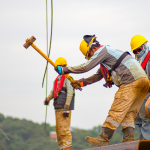Disasters pose significant threats to construction projects. This blog explores proactive measures and strategies to enhance disaster preparedness and build resilient infrastructure, ensuring project continuity and mitigating risks.
1. Risk Assessment and Vulnerability Analysis:
Conduct comprehensive risk assessments and vulnerability analyses to identify potential hazards and their impacts on construction sites. Evaluate the likelihood and severity of disasters, including natural events like hurricanes, earthquakes, and floods, as well as human-made risks such as accidents and cyberattacks.
2. Incorporating Resilience into Design and Planning:
Integrate resilience principles into project design and planning processes to enhance structural integrity and mitigate disaster risks. Consider factors like building codes, material selection, and site location to minimize vulnerabilities and improve resilience against various hazards.
3. Emergency Response and Evacuation Procedures:
Develop and implement robust emergency response and evacuation procedures to ensure the safety of workers and stakeholders in the event of a disaster. Conduct regular drills and training sessions to familiarize personnel with evacuation routes, emergency protocols, and communication procedures.
4. Backup Systems and Redundancies:
Install backup systems and redundancies to maintain critical operations and infrastructure functions during disasters. This includes backup power generators, redundant communication systems, and alternative supply chains to minimize disruptions and ensure continuity of essential services.
5. Collaborative Partnerships and Stakeholder Engagement:
Forge collaborative partnerships with local authorities, emergency responders, and community organizations to enhance disaster preparedness and response capabilities. Engage stakeholders in the planning process to identify risks, prioritize actions, and coordinate response efforts effectively.
6. Continuity Planning and Business Resilience:
Develop business continuity plans to sustain operations and minimize financial losses during and after disasters. Identify key business functions, critical resources, and alternative strategies for maintaining essential services and operations in challenging circumstances.
7. Post-Disaster Recovery and Reconstruction:
Prepare for post-disaster recovery and reconstruction efforts by establishing clear protocols and resources for assessing damage, mobilizing response teams, and restoring infrastructure. Implement measures to expedite recovery efforts and minimize downtime to resume normal operations quickly.
Conclusion:
Building resilient infrastructure requires proactive planning, investment in preparedness measures, and collaboration among stakeholders. By incorporating resilience principles into design, planning, and operations, construction projects can withstand disasters, protect assets, and ensure the safety and well-being of workers and communities.


